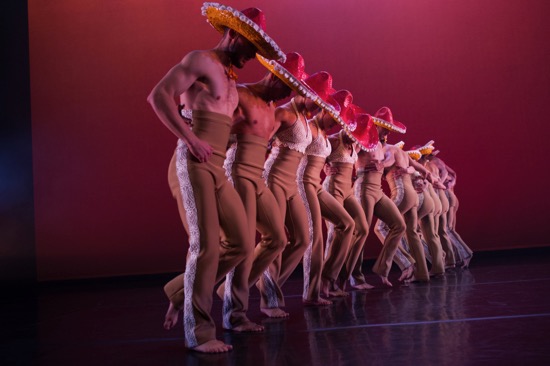
Ballet Hispanico dancers in Michelle Manzanales’s Con Brazos Abiertos. Photo: Paula Lobo
This year, Ballet Hispanico will celebrate its 47th anniversary. I know, I know. In the performing-arts world, we only go all out for a year that ends in zero or five. But what’s immodest about a company being proud of its achievements in other years? Especially since the modestly scaled school and company that Tina Ramirez founded in 1970 has extended its dedication to dance and Hispanic culture to include Arts and Education Residencies; Community Arts Partnerships; a junior company, BHdos; the Instituto Coreografiico; plus panels, forums, exhibitions and other public programming at its Arnhold Center.
On the third night of Ballet Hispanico’s Joyce Theater seven-performance season, the house was not only packed; the spectators treated the occasion as a big, happy night out, rewarding the company with respect, excitement, and delight. And here’s something worth celebrating: all three pieces on the program were by women (a first for the company, I believe). Two were composed after Eduardo Vilaro took over as the company’s artistic director: Annabelle Lopez Ochoa’s Línea Recta (2016) and Michelle Manzanales’s Con Brazos Abiertos (a world premiere); the third, Tonia Pérez-Salas’s 3.Catorce Dieciséis appeared in 2002, when Ramirez was still in charge.
The term “hispanic” covers a lot of ground—chiefly referring to Spanish-speaking countries that were once part of the Spanish Empire. But so many other cultural influences have mingled in them that Ballet Hispanico’s profile is that a melting pot in which ballet and modern dance figure and transform.
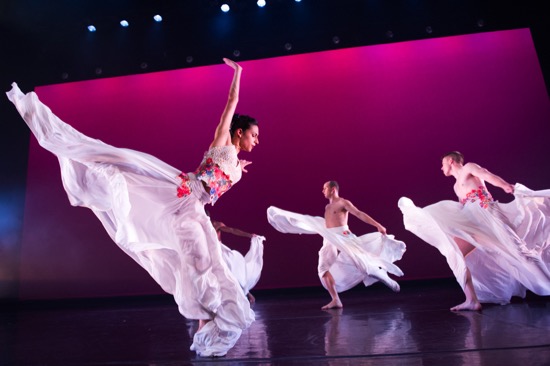
Michelle Manzanales’s Con Brazos Abiertos. (L to R): Melissa Fernandez, Joshua Winzeler, and Nick Fearon. Photo: Paula Lobo
Manzanales was born in Houston, Texas, and the “soundscape” for Con Brazos Abiertos includes, among many others, Julio Iglesias, Juan Carlos Marin Marin, Maria Billini-Padilla, Carla Morrison (whose song “Este Momento” provided the dance’s title), Cheech and Chong’s “Mexican Americans” number, and the voice of actor-agitator Edward James Olmos. Ray Doñes is credited as artistic collaborator.
Con Brazos Abiertos begins with dancers entering one by one to the sound of Morris’s little-girl voice; their parade snakes back and forth across the stage, gradually moving forward.. The men wear white boxer shorts, the women lacy white underwear, as if to suggest a neutral underpinning that will be overlaid with other cultural allusions and clichés. After a blackout, we’re hearing Cheech’s “Mexican” voice, and all fourteen dancers appear wearing high-waisted pants and sombreros that are red on the outside and yellow underneath (costumes by Diana Ruettiger). Evoking the “sleeping Mexican” image that decades ago use to figure on bookends and ash trays, the performers keep their heads down as they dance in snappy formations. They collapse at the end of this, and in the dimming light, crawl and roll slowly offstage, leaving Diana Winfree alone and sitting in a spotlit circle (lighting by Joshua Preston). This woman regards her hat as a tradition breaker—an object she can balance on her foot and negotiate trickily around; “mira me!” sings a woman’s voice.
Many clever costume additions and changes in the color of the backdrop emphasize the flow of incidents: cast members watching, say, Mario Ismael Espinoza and Christopher Bloom dancing out a brotherly pact; Winfree standing on Lyvan Verdecia’s thighs and plummeting down into his arms, men and women entering clad in long, full white skirts that spiral and drift around them; whooping and laughing as they celebrate together. Manzanales sends out such a complex of ideas about tradition, clichéd perspectives, individuality, and male-female relations that her overall theme of heritage and diversity sometimes sputters, but the dancers perform Con Brazos Abiertos with understanding and devotion..
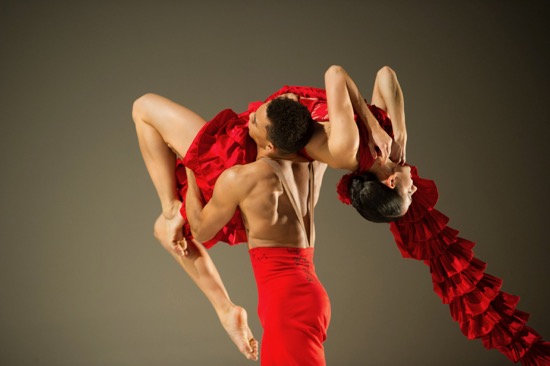
Melissa Fernandez and Lyvan Verdecia of Ballet Hispanico in Annabelle Lopez Ochoa’s Línea Recta. Photo: Paula Lobo
The Belgian-Colombian Lopez Ochoa has created works for more than forty companies around the world—groups diverse as the New York City Ballet and Luna Negra Dance Theater. Línea Recta, her third piece for Ballet Hispanico, focuses on aspects of flamenco, transforming them as she goes. Gorgeous Melissa Fernandez, who begins the work alone onstage, is wearing a costume by Danielle Truss that both alludes to and challenges classical flamenco attire. Its long, ruffled, red train looks to be only about a foot wide; it follows her and winds around her like a snake or a lascivious tongue, leaving her legs bare. Spotlit by Michael Mazzola and dancing to the guitar of Eric Vaarzon Morel’s score, she will, over the course of the dance, drag it between her legs, as well as holding it in her teeth while she turns with one leg lifted behind her in attitude.
The program note mentions Línea Recta’s connection to flamenco’s “conspicuous absence of physical contact between dancers.” Really? That may be true in some of Fernandez’s meetings with four collaborating cavaliers—evidently good friends, who link together to express solidarity. They can use her train to wind her in or spin her away, to pull against it as if she were a horse attempting to run away. However, they also partner her one by one, beginning with Espinoza (who brings remarkable depth and nuance to his dancing). Each man performs differently for and with Fernandez. Verdecia takes over from Espinoza and is supplanted by Mark Gieringer. Lopez Ochoa finds differing ways of dealing with the flamenco male’s proud turkey-cock chest, flourished gestures, domineering manner, and whip-fast turns. Her style for the piece also involves dancers, their feet wide apart, sinking deeply, as if preparing to attack.
When the fourth man (Bloom) enters, and Fernandez kicks the others away, you can forget that program note. Bloom swings her around at floor level and onto his shoulder. So this is about rivalry. She inspects them all, and each takes a turn lifting her. The dancing is elegantly engineered to show us the men’s camaraderie and incisive dancing.
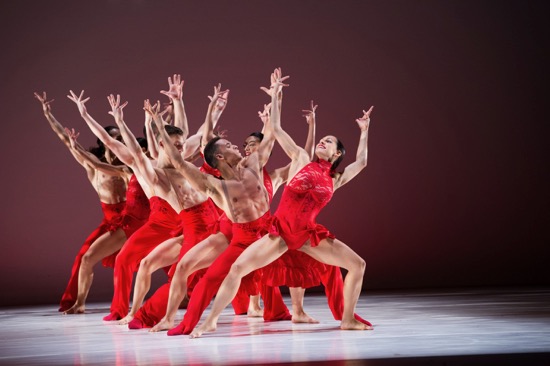
Ballet Hispanico dancers in Annabelle Lopez Ochoa’s Línea Recta. Photo: Paula Lobo
The second part of Línea Recta brings in three women wielding two fans each, plus projections of white patterns that resemble skeletal versions of designs on Spanish tiles. Now Eila Vallis is the woman who captures the men’s attention, and Verdecia and Gieringer collaborate in lifting her and entangling with her in remarkable ways. The sound of Vaarzon Morel’s guitar is embellished by rhythmic clapping and the cantaor’s harsh voice. In the end, the music speeds up, sucking the men and women into a fiesta of dancing, clapping and whooping.
These two dances are very showy, and the audience is delighted. But one of the things I admire most is the way the dancers perform. You can celebrate them as individuals. They face us and dance in unison a good part of the time, but there’s no show-biz gloss in what they do. They fully inhabit the movement and perform it for—as well as with—one another. The one time that a single dancer flashed a smile directly at the front rows was a surprise, but even that seemed real rather than synthetic. And their frequent forays into circles and clusters cement the image of a society working and partying together.
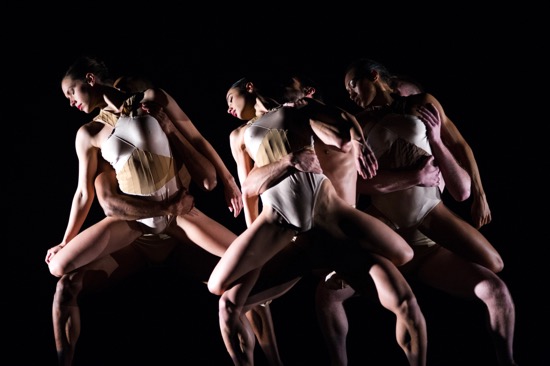
Tania Pérez-Salas’s 3. Catorce Dieciséis. Women (L to R): Diana Winfree, Eila Valls, and Jenna Marie. Photo: Paula Lobo
Pérez-Salas was born in Mexico and has headed her own company there since 1994, but her 3.Catorce Dieciséis doesn’t foreground a particular culture. The title refers to π (“pi” or 3.1416 and on into eternity), which is defined as a mathematical constant, the ratio of a circle’s circumference to its diameter or to its area (remember πr2?). So imagine the dancers as factors creating an equation we may not quite understand. It begins with them dressed in white, walking—now one, now another—to new positions; what they are accomplishing by so doing is an enigma, an interesting process with no certain outcome. Except, of course, a dance. They also, backs to us, break out into more strenuous statements in place—again one or two at a time.
The accompanying music is from the Baroque era: Marais, Frescobaldi, Vivaldi, Couperin, and Pergolesi. The first instrument we hear is a harpsichord, and the last part of the dance brings in a chorus of voices. The lighting for the first two pieces on the program created orgies of color in terms of background; Bob Franklin’s lighting for 3. Catorce Dieciéis is more somber—darkness pierced by beams.
As the lighting changes, so do the costumes. In one highly effective theatrical moment, each of two women wearing long black dresses is imprisoned by a person concealed behind her; all we see of them are those extra groping, embracing arms. Suddenly, the black gowns are whisked away in a single gesture by the invisible handlers, who turn out to be female too. This is the first of two contrapuntal passages that Pérez-Salas creates for a group of three versus a two-person unit. In this case, it’s the two women in red and three in skimpier black outfits. The mingling of two and three keeps shifting (e.g. one in red and two in black, plus one in red and one in black). Similar, very interesting shifts of allegiance occurs when five men appear to play the three-plus-two game.
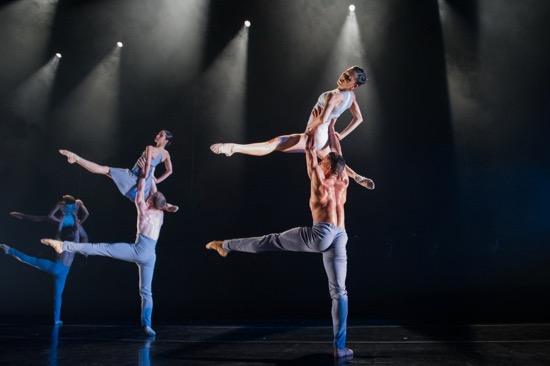
3. Catorce Dieciséis. Couple second from left: Eila Valls and Nick Fearon; right: Melissa Fernandez and Lyvan Verdecia. Photo: Paula Lobo
It’s all very dramatic. The white rays aim in various directions; windows of light appear on the floor; smoke drifts above; the stage becomes a gloomy place. People wear now white, now black, now gray. They kneel, cluster, roll on the floor and over one another into a pile. Men lift and pull and swing women in duets (Shelby Colona with Gieringer, then Fernandez with Nick Fearon). Three identical duets are performed shoulder-to-shoulder. In the end, the smoke really pours down.
What bothered me about 3. Catorce Dieciséis is its sameness of pace: medium fast, and thrusting in terms of dynamics; I found myself yearning for a sustained or slow passage. And the significance of its mysteries continue to elude me. Π is known as an “irrational” number, and perhaps a degree of unreason in the choreography fogged my brain. But the dancers (Ashley Anduiza, Zultari (Zui) Gomez, Nathaniel Hunt, Jenna Marie, Joshua Winzeler are company members not mentioned yet) perform the piece as if they understand every turn of events and every flick of a foot. The audience rewarded them with a standing ovation.

I’m so glad I found your blog! Your content is so interesting, I loved this post. Will have to share with my regular customers.
“a snake or a lascivious tongue”…brilliant, Ms. Jowitt, many thanks.